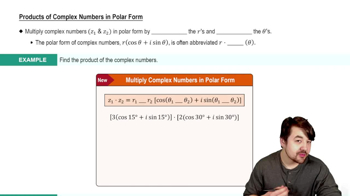Table of contents
- 0. Review of College Algebra4h 43m
- 1. Measuring Angles39m
- 2. Trigonometric Functions on Right Triangles2h 5m
- 3. Unit Circle1h 19m
- 4. Graphing Trigonometric Functions1h 19m
- 5. Inverse Trigonometric Functions and Basic Trigonometric Equations1h 41m
- 6. Trigonometric Identities and More Equations2h 34m
- 7. Non-Right Triangles1h 38m
- 8. Vectors2h 25m
- 9. Polar Equations2h 5m
- 10. Parametric Equations1h 6m
- 11. Graphing Complex Numbers1h 7m
1. Measuring Angles
Complementary and Supplementary Angles
Problem 22
Textbook Question
In Exercises 21–28, an object moves in simple harmonic motion described by the given equation, where t is measured in seconds and d in inches. In each exercise, find the following: a. the maximum displacement b. the frequency c. the time required for one cycle. d = 10 cos 2πt
 Verified step by step guidance
Verified step by step guidance1
<b>Step 1:</b> Identify the amplitude of the motion from the equation \(d = 10 \cos 2\pi t\). The amplitude is the coefficient of the cosine function, which represents the maximum displacement. In this case, it is 10 inches.
<b>Step 2:</b> Determine the frequency of the motion. The frequency is related to the coefficient of \(t\) inside the cosine function. Here, the coefficient is \(2\pi\), which indicates that the frequency \(f\) is 1 cycle per second (since \(2\pi\) is the angular frequency and \(f = \frac{\text{angular frequency}}{2\pi}\)).
<b>Step 3:</b> Calculate the time required for one cycle, also known as the period \(T\). The period is the reciprocal of the frequency. Since the frequency is 1 cycle per second, the period \(T = \frac{1}{f} = 1\) second.
<b>Step 4:</b> Review the characteristics of simple harmonic motion. The maximum displacement (amplitude) is the farthest distance the object moves from its equilibrium position, and the period is the time it takes to complete one full cycle of motion.
<b>Step 5:</b> Verify the understanding of the cosine function in the context of simple harmonic motion. The function \(d = 10 \cos 2\pi t\) describes a motion that starts at the maximum displacement when \(t = 0\), oscillates back and forth, and completes a full cycle in 1 second.
Recommended similar problem, with video answer:
 Verified Solution
Verified SolutionThis video solution was recommended by our tutors as helpful for the problem above
Video duration:
3mPlay a video:
Was this helpful?
Key Concepts
Here are the essential concepts you must grasp in order to answer the question correctly.
Simple Harmonic Motion (SHM)
Simple Harmonic Motion is a type of periodic motion where an object moves back and forth around an equilibrium position. The motion can be described by a sinusoidal function, such as sine or cosine, which captures the oscillatory nature of the movement. In the given equation, the cosine function indicates that the object starts at its maximum displacement.
Recommended video:

Products of Complex Numbers in Polar Form
Maximum Displacement
Maximum displacement, also known as amplitude, refers to the furthest distance the object moves from its equilibrium position during its oscillation. In the equation d = 10 cos 2πt, the coefficient '10' represents the maximum displacement in inches, indicating that the object oscillates between +10 and -10 inches from the center position.
Frequency and Period
Frequency is the number of cycles an object completes in one second, while the period is the time taken to complete one full cycle. In the equation, the term '2π' in the cosine function indicates the angular frequency, which can be used to calculate the frequency as 1 cycle per second. The period, which is the reciprocal of frequency, tells us how long it takes for the object to return to its starting position.
Recommended video:

Period of Sine and Cosine Functions

 3:35m
3:35mWatch next
Master Intro to Complementary & Supplementary Angles with a bite sized video explanation from Patrick Ford
Start learningRelated Videos
Related Practice








